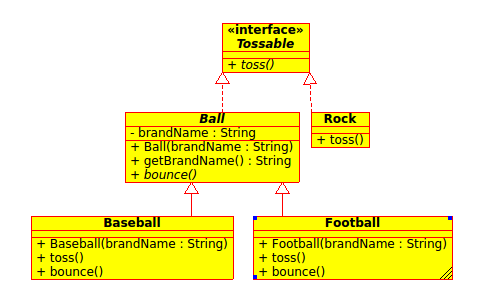
Java Interfaces and UML
Consider the following UML diagram:

(Notice that Ball is in italics, indicating that it is abstract.)
- Fill in the table below with one of three values.
- ✓ An object of the indicated type could be stored in a variable of the indicated type.
- X An object of the indicated type could not be stored in a variable of the indicated type.
- — It is not possible to instantiate an object of the indicated type.
For example, the cell marked with red would represent the following assignment:
// Variable type: Football / Object type: Tossable Football ball = new Tossable();
This cell should is marked — because it is impossible to instantiate an object of typeTossable.Variable Type Tossable Ball Rock Baseball Football Object Type Tossable — Ball Rock Baseball Football - Which of the following will compile and execute successfully (mark with C E)? Which of the following will compile, but result in a runtime error (mark with a C)? Which will not compile (mark with an N)?
1. Ball ball = new Football("Spalding"); 2. Ball ball = new Football("Spalding"); Baseball baseball = (Baseball)ball; 3. Object obj = new Baseball("Spalding"); 4. Object obj = new Baseball("Spalding"); Tossable tossable = obj; 5. Tossable tossable = new Baseball("Spalding"); Object obj = tossable; 6. Tossable tossable = new Baseball("Spalding"); tossable.getBrandName(); -
Provide a java implementation corresponding to the UML above. You do
not need to fill in the method bodies for the
tossorbouncemethods.